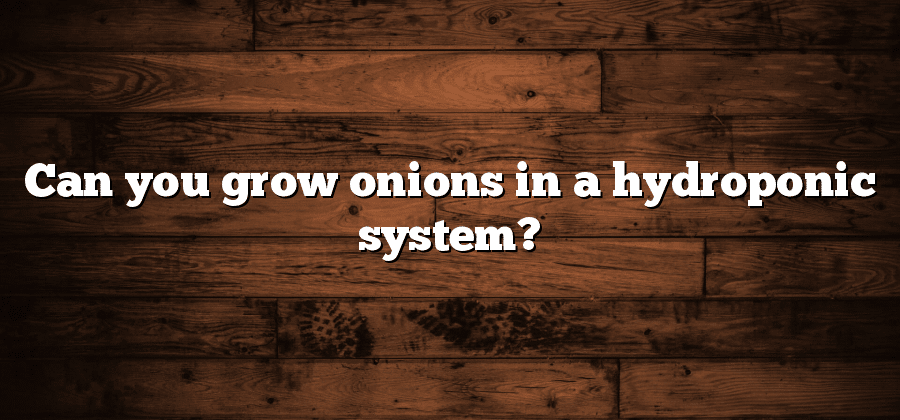Benefits of Hydroponic Onion Cultivation
Hydroponic onion cultivation offers numerous benefits to farmers and gardeners alike. Firstly, this method allows for year-round production, eliminating the dependency on seasonal changes. Unlike traditional soil-grown onions, hydroponic onions can be grown in controlled environments, optimizing the growth conditions and ensuring a steady supply throughout the year. Moreover, since hydroponic systems do not require soil, they are less susceptible to soil-borne diseases and pests, reducing the need for chemical pesticides and herbicides.
Another advantage of hydroponic onion cultivation is its space efficiency. With the use of vertical growing systems, such as tower gardens or stacked trays, onions can be grown in tight spaces, maximizing the land area. This is especially beneficial for urban farmers or those with limited space for cultivation. Additionally, the controlled environment of hydroponic systems allows for higher yields compared to traditional methods, enabling farmers to produce more onions in a smaller area. This not only increases productivity but also contributes to resource conservation, as less water and nutrients are required per unit of crop.
Selection of Onion Varieties
One of the key aspects of successful hydroponic onion cultivation is selecting the right variety. With numerous onion varieties available, it is essential to choose those that are well-suited for hydroponic growing conditions. When selecting onion varieties, growers should consider characteristics such as bulb size, flavor, and storage capabilities.
Bulb size is an important factor to consider, as it plays a significant role in marketability. Generally, larger bulbs are preferred for commercial purposes, while smaller bulbs are often used for personal consumption or culinary purposes. Furthermore, the flavor profile of the onion variety should align with consumer preferences, whether it is mild and sweet or more strong and pungent. Finally, the storage capabilities of the onion variety should be taken into account, as certain varieties can be stored for longer periods without compromising their quality. By considering these factors, growers can choose onion varieties that will ultimately yield a successful hydroponic crop.
Ideal Growing Conditions for Onions
Onions, a versatile and flavorful vegetable, can be cultivated successfully in hydroponic systems. However, to achieve optimal growth and yield, it is crucial to create the ideal growing conditions. One important aspect is providing adequate light. Onions require at least 14-16 hours of direct or indirect sunlight each day. Therefore, it is recommended to use artificial lighting, such as high-intensity discharge (HID) lamps, to supplement natural light and ensure consistent photosynthesis.
Moreover, maintaining the proper temperature is essential for onion cultivation in hydroponic systems. Ideal daytime temperatures range between 65-75°F (18-24°C), while nighttime temperatures should be slightly cooler, around 55-65°F (13-18°C). Consistency is key, as fluctuations in temperature can hinder growth and lead to diseases. Utilizing temperature control devices, such as heaters and coolers, can help maintain the desired range and ensure optimal conditions for onion plants to thrive.
Preparation of Hydroponic System
The preparation of a hydroponic system for onion cultivation plays a critical role in ensuring healthy plant growth and abundant harvests. One of the first steps is to select a suitable container or growing bed for the hydroponic setup. This container should be spacious enough to accommodate the desired number of onion plants and have proper drainage to prevent waterlogging. It is also important to thoroughly clean and sterilize the container before use to eliminate any potential pathogens or contaminants that could harm the plants.
After selecting the container, the next step is to install the necessary equipment for nutrient delivery. This includes setting up a reservoir to hold the nutrient solution, an irrigation pump to deliver the solution to the plants, and a timer or automated system to regulate the watering schedule. Additionally, a pH meter and an electrical conductivity (EC) meter should be used to monitor and adjust the pH and nutrient levels in the solution.
Once the equipment is in place, the next step is to mix and prepare the nutrient solution. It is important to use a high-quality hydroponic nutrient solution specifically formulated for onion cultivation. Following the manufacturer’s instructions, the appropriate amount of nutrients should be dissolved in water according to the desired nutrient strength. It is crucial to regularly monitor and adjust the nutrient solution to ensure optimal nutrient levels for the onions.
Overall, the preparation of a hydroponic system for growing onions involves selecting the right container, installing the necessary equipment, and properly preparing the nutrient solution. By ensuring these steps are carried out meticulously, hydroponic onion cultivators can lay a strong foundation for healthy and productive plants.
Planting Techniques for Hydroponic Onions
Planting techniques play a crucial role in the successful cultivation of hydroponic onions. When it comes to hydroponics, the first step is to ensure that the seedlings are strong and healthy before transplanting them into the system. This can be achieved by starting the seeds in a separate container filled with a suitable growing medium. Once the seedlings have reached the desired size, they can be carefully transferred into the hydroponic system.
In the hydroponic system, it is important to space the onion plants appropriately to allow for their proper growth and development. Each plant should be given enough space to expand its root system and access the necessary nutrients and water. Additionally, regular monitoring of the system is essential to ensure a balanced nutrient solution and proper pH levels. This will help in maintaining optimal conditions for the onions to grow and thrive.






